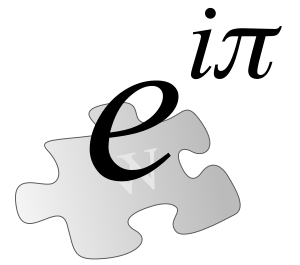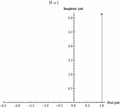Euler's identity facts for kids
Euler's identity, sometimes called Euler's equation, is this equation:

It features the following mathematical constants:
 , pi
, pi
 , Euler's Number
, Euler's Number
 , imaginary unit
, imaginary unit

It also features three of the basic mathematical operations: addition, multiplication and exponentiation.
Euler's identity is named after the Swiss mathematician Leonard Euler. It is not clear that he invented it himself.
Respondents to a Physics World poll called the identity "the most profound mathematical statement ever written", "uncanny and sublime", "filled with cosmic beauty" and "mind-blowing".
Contents
Mathematical proof of Euler's Identity using Taylor Series
Many equations can be written as a series of terms added together. This is called a Taylor series.
The exponential function  can be written as the Taylor series
can be written as the Taylor series

As well, the sine function can be written as

and cosine as

Here, we see a pattern take form.  seems to be a sum of sine and cosine's Taylor series, except with all of the signs changed to positive. The identity we are actually proving is
seems to be a sum of sine and cosine's Taylor series, except with all of the signs changed to positive. The identity we are actually proving is  .
.
So, on the left side is  , whose Taylor series is
, whose Taylor series is 
We can see a pattern here, that every second term is i times sine's terms, and that the other terms are cosine's terms.
On the right side is  , whose Taylor series is the Taylor series of cosine, plus i times the Taylor series of sine, which can be shown as:
, whose Taylor series is the Taylor series of cosine, plus i times the Taylor series of sine, which can be shown as:

if we add these together, we have

Therefore,

Now, if we replace x with  , we have:
, we have:

Since we know that  and
and  , we have:
, we have:
which is the statement of Euler's identity.
Related pages
pl:Wzór Eulera#Tożsamość Eulera
Images for kids
-
In this animation N takes various increasing values from 1 to 100. The computation of (1 + iπN)N is displayed as the combined effect of N repeated multiplications in the complex plane, with the final point being the actual value of (1 + iπN)N. It can be seen that as N gets larger (1 + iπN)N approaches a limit of −1.
See also
 In Spanish: Identidad de Euler para niños
In Spanish: Identidad de Euler para niños






